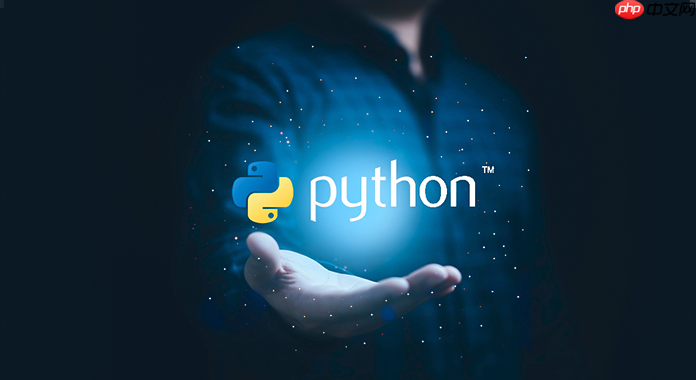使用warnings.filterwarnings('ignore')可全局屏蔽警告;2. 通过warnings.filterwarnings('ignore', category=userwarning)可屏蔽特定类型警告;3. 利用with warnings.catch_warnings(): warnings.simplefilter("ignore")可在代码块内临时屏蔽警告;4. 调用matplotlib.set_loglevel('error')可抑制matplotlib内部日志级别的输出;5. 重定向sys.stdout和sys.stderr到os.devnull可彻底屏蔽所有标准输出和错误信息,但需在操作后恢复原流以避免影响后续代码执行,该方法适用于需要完全静音输出的场景且应谨慎使用。

在Python编程,特别是进行数据分析和可视化时,我们经常会遇到各种输出信息,其中就包括Matplotlib的绘图警告。要屏蔽这些输出,最直接的方法是利用Python内置的
warnings
要有效屏蔽Python的输出信息,特别是Matplotlib的绘图警告,我们可以采取以下几种策略:
使用warnings
立即学习“Python免费学习笔记(深入)”;
全局忽略所有警告:这是一种简单粗暴但有时很有效的方法,尤其是在你确定所有警告都可以被忽略时。
import warnings
warnings.filterwarnings('ignore')
# 你的代码,例如Matplotlib绘图
import matplotlib.pyplot as plt
plt.plot([1, 2, 3])
plt.show()忽略特定类型的警告:更推荐的做法是只忽略你了解且认为无害的警告类型。例如,如果Matplotlib发出的警告属于
UserWarning
import warnings
warnings.filterwarnings('ignore', category=UserWarning)
# 你的Matplotlib绘图代码
import matplotlib.pyplot as plt
plt.plot([1, 2, 3])
plt.show()使用上下文管理器临时忽略警告:这是最优雅的方式,只在特定代码块内屏蔽警告,避免影响其他部分的警告提示。
import warnings
import matplotlib.pyplot as plt
with warnings.catch_warnings():
warnings.simplefilter("ignore") # 或者 warnings.filterwarnings('ignore', category=UserWarning)
plt.plot([1, 2, 3])
plt.show()
# 此处警告处理恢复到之前的设置控制Matplotlib自身的日志级别: Matplotlib内部也使用了日志系统,你可以通过设置其日志级别来控制输出。
import matplotlib
matplotlib.set_loglevel('error') # 只显示错误信息,忽略警告和更低级别的信息
import matplotlib.pyplot as plt
plt.plot([1, 2, 3])
plt.show()可选的级别包括
'notset'
'debug'
'info'
'warning'
'error'
'critical'
'error'
'critical'
重定向sys.stdout
sys.stderr
import os
import sys
import matplotlib.pyplot as plt
# 创建一个空文件或直接重定向到操作系统的“黑洞”设备
# 在Unix/Linux/macOS上:/dev/null
# 在Windows上:nul
original_stdout = sys.stdout
original_stderr = sys.stderr
# 选择一个适合你操作系统的“黑洞”设备
devnull = open(os.devnull, 'w') # os.devnull 会自动选择合适的设备
sys.stdout = devnull
sys.stderr = devnull
try:
# 你的代码,包括可能产生print()输出或Matplotlib绘图的代码
print("这条信息不会显示在控制台")
plt.plot([1, 2, 3])
plt.show() # 这行本身不会有输出,但Matplotlib内部的警告可能会被抑制
finally:
# 确保在代码执行完毕后恢复原始的stdout和stderr,避免影响后续操作
sys.stdout = original_stdout
sys.stderr = original_stderr
devnull.close()
print("这条信息会正常显示")这种方法非常强大,但使用时要小心,因为它会屏蔽所有通过
print()
sys.stdout
sys.stderr
说实话,有时候那些密密麻麻的输出,真的会让我头大。想象一下,你在一个大型数据处理流程中,或者在构建一个自动化脚本,每次运行都蹦出一堆不痛不痒的警告信息,甚至是一些内部库的调试打印。这不仅让控制台看起来一团糟,更重要的是,它会分散你的注意力,让你难以捕捉到真正重要的错误或提示。
从实际开发的角度来看,屏蔽不必要的输出有几个核心原因:
所以,这不仅仅是为了“眼不见心不烦”,更是为了让我们的开发和部署流程更加高效、专业。
控制Python的输出,不只是处理警告那么简单,它其实涉及到对整个标准输出流(
sys.stdout
sys.stderr
warnings
print()
sys.stdout
sys.stderr
要全面地“静音”或者说管理这些输出,最直接也最强大的工具就是重定向
sys.stdout
sys.stderr
/dev/null
nul
具体操作起来,就是把
sys.stdout
sys.stderr
import sys
import os
# 保存原始的stdout和stderr,以便之后恢复
_original_stdout = sys.stdout
_original_stderr = sys.stderr
# 打开一个“黑洞”文件
# os.devnull 是一个跨平台的常量,代表空设备
_devnull = open(os.devnull, 'w')
def suppress_output():
"""临时抑制所有标准输出和标准错误"""
sys.stdout = _devnull
sys.stderr = _devnull
def resume_output():
"""恢复标准输出和标准错误"""
sys.stdout = _original_stdout
sys.stderr = _original_stderr
_devnull.close() # 在不再需要时关闭文件
# 示例用法
# 开启屏蔽
suppress_output()
print("这条信息不会在控制台显示")
import matplotlib.pyplot as plt
# Matplotlib的内部打印或警告(如果不是通过warnings模块发出的)也可能被抑制
plt.plot([1, 2, 3])
plt.show()
# 恢复输出
resume_output()
print("这条信息会正常显示")这种方法非常激进,它会“吞噬”所有写入标准输出和标准错误的信息。因此,通常建议只在明确知道不需要这些输出的特定代码块中使用,并且务必在操作完成后恢复原始的
sys.stdout
sys.stderr
warnings
Matplotlib在绘图过程中确实会产生各种警告,有时候它们有点“杞人忧天”,但有时候也确实能帮我们发现一些潜在的问题。常见的Matplotlib警告包括:
FutureWarning: The 'fmt' argument of 'axes.plot' is deprecated since Matplotlib 3.8 and will be removed in 3.10.
UserWarning: The figure layout has not been constrained. The figure will adjust to the layout of the subplots.
对于这些警告,我们不能一概而论地全部屏蔽。精细化管理意味着:
理解警告的含义:花点时间读懂警告信息,判断它是真的问题,还是可以忽略的“噪音”。比如弃用警告,如果你确定短期内不会升级Matplotlib,或者已经知道如何替换,那就可以暂时忽略。布局警告通常是提醒你手动调整布局可能更好,如果你对当前布局满意,也可以忽略。
针对性屏蔽:如果某个警告频繁出现且你确认其无害,可以使用
warnings.filterwarnings
FutureWarning
import warnings
warnings.filterwarnings('ignore', category=FutureWarning)
# 你的Matplotlib代码warnings.filterwarnings('ignore', message='The figure layout has not been constrained.')更稳妥的是查看警告的
category
利用Matplotlib自身的日志级别:这是处理Matplotlib内部警告最直接的方式。
matplotlib.set_loglevel()
import matplotlib
matplotlib.set_loglevel('error') # 设置为error,所有低于error级别的日志(包括warning)都不会显示
import matplotlib.pyplot as plt
fig, ax = plt.subplots()
ax.plot([1, 2, 3])
# 假设这里会触发一个布局警告,但因为设置了loglevel,它不会显示
plt.tight_layout() # 可能触发警告的操作
plt.show()这种方法的好处是,它只影响Matplotlib自己的日志,不会影响Python其他部分的警告处理。
上下文管理器的妙用:如果你只希望在某个特定的绘图函数调用期间屏蔽警告,
warnings.catch_warnings()
matplotlib.set_loglevel()
import warnings
import matplotlib
import matplotlib.pyplot as plt
# 在这个块内,Matplotlib的日志级别被临时设置为error
with warnings.catch_warnings():
warnings.simplefilter("ignore") # 也可以在这里忽略所有Python警告
original_loglevel = matplotlib.get_loglevel() # 保存当前级别
matplotlib.set_loglevel('error') # 临时设置
try:
fig, ax = plt.subplots()
ax.plot([1, 2, 3])
plt.tight_layout()
plt.show()
finally:
matplotlib.set_loglevel(original_loglevel) # 确保恢复
print("绘图完成,Matplotlib日志级别已恢复。")通过这种方式,我们既能保持代码的“安静”,又不会盲目地忽略所有可能重要的信息。平衡点在于,我们既要追求代码的简洁和输出的清晰,也不能因此错过真正需要关注的潜在问题。
以上就是Python屏蔽输出信息如何屏蔽 matplotlib 的绘图警告 Python屏蔽输出信息的 matplotlib 管控技巧的详细内容,更多请关注php中文网其它相关文章!

每个人都需要一台速度更快、更稳定的 PC。随着时间的推移,垃圾文件、旧注册表数据和不必要的后台进程会占用资源并降低性能。幸运的是,许多工具可以让 Windows 保持平稳运行。

Copyright 2014-2025 https://www.php.cn/ All Rights Reserved | php.cn | 湘ICP备2023035733号